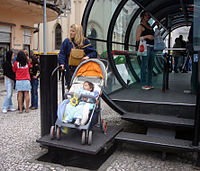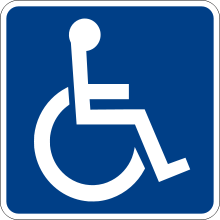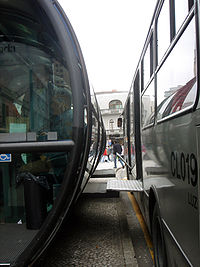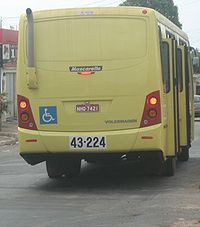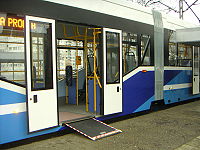- Accessibility
-
For Wikipedia's accessibility policy, see Wikipedia:Accessibility.For the related design concept, see Universal design. For the logical notion, see Accessibility relation. For accessibility on the internet, see Web accessibility.
Accessibility is a general term used to describe the degree to which a product, device, service, or environment is available to as many people as possible. Accessibility can be viewed as the "ability to access" and benefit from some system or entity. Accessibility is often used to focus on people with disabilities or special needs and their right of access to entities, often through use of assistive technology.
Accessibility is not to be confused with usability which is used to describe the extent to which a product (e.g., device, service, environment) can be used by specified users to achieve specified goals with effectiveness, efficiency and satisfaction in a specified context of use.
Accessibility is strongly related to universal design when the approach involves "direct access". This is about making things accessible to all people (whether they have a disability or not). An alternative is to provide "indirect access" by having the entity support the use of a person's assistive technology to achieve access (e.g., screen readers).
The term "accessibility" is also used in the Convention on the Rights of Persons with Disabilities as well as the term "universal design".
Contents
Disabilities
The disability rights movement advocates equal access to social, political, and economic life which includes not only physical access but access to the same tools, services, organizations and facilities which we all pay for. Article 9 of the United Nations Convention on the Rights of Persons with Disabilities commits signatories to provide for full accessibility in their countries.
While it is often used to describe facilities or amenities to assist people with disabilities, as in "wheelchair accessible", the term can extend to Braille signage, wheelchair ramps, elevators, audio signals at pedestrian crossings, walkway contours, website design, reading accessibility, and so on.
Various countries have legislation requiring physical accessibility which are (in order of enactment):
- In the US, under the Americans with Disabilities Act of 1990, new public and private business construction generally must be accessible. Existing private businesses are required to increase the accessibility of their facilities when making any other renovations in proportion to the cost of the other renovations. The U.S. Access Board is "A Federal Agency Committed to Accessible Design for People with Disabilities." The Job Accommodation Network discusses accommodations for people with disabilities in the workplace. Many states in the US have their own disability laws.
- In Australia, the Disability Discrimination Act 1992 has numerous provisions for accessibility.
- In the UK, the Equality Act 2010 has numerous provisions for accessibility.
- In South Africa the Promotion of Equality and Prevention of Unfair Discrimination Act 2000 has numerous provisions for accessibility.
- In Ontario, Canada, the Ontarians with Disabilities Act of 2001 is meant to "improve the identification, removal and prevention of barriers faced by persons with disabilities..."
Transportation
In transportation, accessibility refers to the ease of reaching destinations. Academics have disputed how the term "ease" should be defined and measured. People who are in places that are highly accessible can reach many other activities or destinations quickly, people in inaccessible places can reach fewer places in the same amount of time.
A measure that is often used is to measure accessibility in a traffic analysis zone i is:
 where:
where:- i = index of origin zones
- j = index of destination zones
 = function of generalized travel cost (so that nearer or less expensive places are weighted more than farther or more expensive places).
= function of generalized travel cost (so that nearer or less expensive places are weighted more than farther or more expensive places).
For a non-motorized mode of transport, such as walking or cycling, the generalized travel cost may include additional factors such as safety or gradient.
Transport for London utilise a calculated approach known as Public Transport Accessibility Level (PTAL) that uses the distance from any point to the nearest public transport stops, and service frequency at those stops, to assess the accessibility of a site to public transport services.
Automobile accessibility also refers to ease of use by disabled people.
Accessibility planning
In the United Kingdom, the Department for Transport has mandated that each local authority produce an Accessibility Plan that is incorporated in their Local Transport Plan. An Accessibility Plan sets out how each local authority plans to improve access to employment, learning, health care, food shops and other services of local importance, particularly for disadvantaged groups and areas. Accessibility targets are defined in the accessibility plans, these are often the distance or time to access services by different modes of transport including walking, cycling and public transport.
Accessibility Planning was introduced as a result of the report "Making the Connections: Final Report on Transport and Social Exclusion".[1] This report was the result of research carried out by the Social Exclusion Unit. The United Kingdom also has a "code of practice" for making train and stations accessible: "Accessible Train and Station Design for Disabled People: A Code of Practice".[2] This code of practice was first published in 2002 with the objective of compliance to Section 71B of the Railways Act 1993, and revised after a public consultation period in 2008.
Low floor
- "Low floor" redirects here
See also: Low-floor bus and Low-floor tramA significant development in transportation, and public transport in particular, to achieve accessibility, is the move to "low-floor" vehicles. In a low-floor vehicle, access to part or all of the passenger cabin is unobstructed from one or more entrances by the presence of steps, enabling easier access for the infirm or people with push chairs. A further aspect may be that the entrance and corridors are wide enough to accommodate a wheelchair. Low-floor vehicles have been developed for buses, trolleybuses and trams.
A low floor in the vehicular sense is normally combined in a conceptual meaning with normal pedestrian access from a standard kerb height. However, the accessibility of a low-floor vehicle can also be utilised from slightly raising portions of kerb at bus stops, or through use of level boarding bus rapid transit 'stations' or tram stops. The combination of access from a kerb was the technological development of the 1990s, as step-free interior layouts for buses had existed in some cases for decades, with entrance steps being introduced as chassis designs and overall height regulations changed.
Low-floor buses may also be designed with special height adjustment controls that permit a stationary bus to temporarily lower itself to ground level, permitting wheelchair access. This is referred to as a kneeling bus.
At rapid transit systems, vehicles generally have floors in the same height as the platforms but the stations are often underground or elevated, so accessibility there isn't a question of providing low-floor vehicles, but providing a step-free access from street level to the platforms (generally by elevators, which are somewhere restricted to disabled passengers only, so that the step-free access isn't obstructed by healthy people taking advantage).
Housing
Most existing and new housing, even in the wealthiest nations, lack basic accessibility features unless the designated, immediate occupant of a home currently has a disability. However, there are some initiatives to change typical residential practices so that new homes incorporate basic access features such as zero-step entries and door widths adequate for wheelchairs to pass through. Occupational Therapists are a professional group skilled in the assessment and making of recommendations to improve access to homes.[3] They are involved in both the adaptation of existing housing to improve accessibility,[4] and in the design of future housing.[5]
Great Britain applies the most widespread application of home access to date. In 1999, Parliament passed Section M, an amendment to residential building regulations requiring basic access in all new homes.[6] In the United States, the 1988 Amendments to the Fair Housing Act added people with disabilities, as well as familial status, to the classes already protected by law from discrimination (race, color, gender, religion, creed, and country of origin). Among the protection for people with disabilities in the 1988 Amendments are seven construction requirements for all multifamily buildings of more than four units first occupied after March 13, 1991. These seven requirements are as follows:[7]
- An accessible building entrance on an accessible route,
- Accessible common and public use areas,
- Doors usable by a person in a wheelchair,
- Accessible route into and through the dwelling unit,
- Light switches, electrical outlets, thermostats and other environmental controls in accessible locations,
- Reinforced walls in bathrooms for later installation of grab bars, and
- Usable kitchens and bathrooms.
Access is typically defined within the limits of what a person sitting in a wheelchair is able to reach with arm movement only, with minimal shifting of the legs and torso. Lighting and thermostat controls should not be above and power outlets should not be below the reach of a person in a wheelchair.
Sinks and cooking areas typically need to be designed without cupboards below them, to permit the legs of the wheelchair user to roll underneath, and countertops may be of reduced height to accommodate a sitting rather than standing user. In some cases two food preparation areas may be combined into a single kitchen to permit both standing and wheelchair users.
In spite of these advancements, the housing types where most people in the United States reside – single-family homes – are not covered by the Americans with Disabilities Act, the Fair Housing Act, or any other federal law with the exception of the small percentage of publicly funded homes impacted by Section 504 of the Rehabilitation Act. As a result, the great majority of new single-family homes replicate the barriers in existing homes.
The broad concept of Universal design is relevant to housing, as it is to all aspects of the built environment. Furthermore, a Visitability movement begun by grass roots disability advocates in the 1980s focuses specifically on changing construction practices in new housing. This movement, a network of interested people working in their locales, works on educating, passing laws, and spurring voluntary home access initiatives with the intention that basic access become a routine part of new home construction.
Adaptations and accommodations
Many ranch style homes and manufactured homes utilize a main floor slightly raised above ground level, but have an overall flat layout with either a crawlspace or slightly raised basement below for plumbing, electrical, and heating systems. These homes can be relatively easily modified to accommodate wheelchairs and walkers, with the installation of a long low-rise ramp outside the building, up to the house entrance, placed over the existing stairway. This ramp can then be removed at a later time, reverting back to the stairway entrance if the handicapped access is no longer necessary.
Split level homes tend to be designed with multiple internal stairways and half-floor landings inside the building. There may be an entrance area inside the building at ground level, with stairs inside the entrance that immediately go up and down from the ground level. These homes are difficult to accommodate inexpensively since there is often no space available inside the structure to install long sloping wheelchair ramps to access the various floors. It may be possible to retrofit stair lifts into the stairwells or wheelchair lifts into balconies near the stairwell.
Multi-story homes can sometimes be accommodated by installing a private residential elevator, which is usually much less expensive and has fewer design and layout requirements than a full commercial elevator. Homebuilders can in some cases plan for a future residential elevator by designing closet spaces in each floor stacked vertically with the same dimensions and location. At a later time the closet floors and ceilings are removed and the elevator equipment is installed into the open shaft.
Telecommunications and IT access
Main article: Design for All (in ICT)Another dimension of accessibility is the ability to access information and services by minimizing the barriers of distance and cost as well as the usability of the interface. In many countries this has led to initiatives, laws and regulations that aim toward providing universal access to the internet and to phone systems at reasonable cost to citizens.[8]
The following disabilities interfere with telecommunications and technology access, as well as many other life activities.
- Speech disorder[9]
- Hearing impairment[10]
- Visual impairment[11]
- Limb deformity or injury
Each kind of disability requires a different kind of accommodation, and this may require analysis by a medical specialist and job analysis when the impairment requires accommodation.
One of the first areas where information technology improved the quality of life for disabled individuals is the voice operated wheelchair. Quadriplegics have the most profound disability, and the voice operated wheel chair technology was first developed in 1977 to provide increased mobility. The original version replaced the joystick system with a module that recognized 8 commands. Many other technology accommodation improvements have evolved from this initial development.[13]
Missing arms and fingers interferes with the use of a keyboard and pointing device (mouse). This can be one of the most devastating types of handicap, and technology has made great improvements in this area during the last 20 years. Speech recognition devices and software can improve technology access.
A speech disorder interferes with the ability to produce clearly understandable speech. There can be many different causes, such as nerve degeneration, muscle degeneration, stroke, and vocal cord injury.
The modern method to deal with speaking disabilities has been to provide a text interface for a speech synthesizer for complete vocal disability. This can be a great improvement for people that have been limited to the use of a throat vibrator to produce speech since the 1960s.
An individual satisfies the definition of hearing disabled when hearing loss is about 30dB for a single frequency, but this is not always perceptible as a handicap. For example, loss of sensitivity in one ear interferes with sound localization (directional hearing), which can interfere with communication in a crowd. This is often recognized when certain words are confused during normal conversation. This can interfere with voice-only interfaces, like automated customer service telephone systems, because it is sometimes difficult to increase the volume and repeat the message.
Mild to moderate hearing loss may be accommodated with a hearing aid that amplifies ambient sounds. Portable devices with speed recognition that can produce text can reduce problems associated with understanding conversation. This kind of hearing loss is relatively common, and this often grows worse with age.
The modern method to deal with profound hearing disability is the Internet using email or word processing applications. The Telecommunication Device for the Deaf (TDD) became available in the form of the teletype (TTY) during the 1960s. These devices consist of a keyboard, display and modem that connects two or more of these devices using a dedicated wire or plain old telephone service.
- Telecommunications device for the deaf
- Teleprinter
- Plain old telephone service
- Absolute threshold of hearing
Visual impairment can be one of the most difficult kinds of handicap.
A wide range of technology products are available to deal with visual impairment. This includes screen magnification for monitors, mouse-over speech synthesis browsing, braille displays, braille printers, braille cameras, voice operated phones and tablets.
- Speech synthesis[24]
- Touch Sight Camera for the Blind[25]
- Vision: Apple[26]
- Opera Voice Browsing[27]
- Firefox Voice Browsing[28]
- Voice Control: Apple[29]
- Refreshable Braille display
One emerging product that will make ordinary computer displays available for the blind is the refreshable tactile display, which is very different from a conventional braille display. This provides a raised surface corresponding to the bright and dim spots on a conventional display, much like the Touch Sight Camera for the Blind.
Speech Synthesis Markup Language and Speech Recognition Grammar Specification are emerging technologies intended to standardize communication interfaces using BNF Form and XML Form. These technologies assist visual impairments and physical impairment by providing interactive access to web content without the need to visually observe the content. While these technologies provides access for visually impaired individuals, the primary benefactor has been automated systems that replace live human customer service representatives that handle telephone calls.
Web Access
Currently there are a few major movements to coordinate a set of guidelines for accessibility for the web. The first and most well known is The Web Accessibility Initiative (WAI), which is part of the World Wide Web Consortium (W3C). This organization developed the Web Content Accessibility Guidelines (WCAG) 1.0 which explains how to make Web content accessible to people with disabilities. Web "content" generally refers to the information in a Web page or Web application, including text, images, forms, sounds, and such. (More specific definitions are available in the WCAG documents.)[33]
The WCAG is separated into 3 levels of compliance, A, AA and AAA. Each level requires a stricter set of conformance guidelines, such as different versions of HTML (Transitional vs Strict) and other techniques that need to be incorporated into your code before accomplishing validation. Online tools allow users to submit their website and automatically run it through the WCAG guidelines and produce a report, stating whether or not they conform to each level of compliance. Adobe Dreamweaver also offers plugins which allow web developers to test these guidelines on their work from within the program.
Another source of web accessibility guidance comes from the US government. Section 508 of the US Rehabilitation Act is a comprehensive set of rules designed to help web designers make their sites accessible. The U.S. General Services Administration have also developed a website where one can take online training courses for free to learn about these rules.[34]
In general, for a website to comply with accessibility standards, they should at least have the following:
- (X)HTML Validation from the W3C for the pages content
- CSS Validation from the W3C for the pages layout
- At least WAI-AA (preferably AAA) compliance with the WAI's WCAG
- Compliance with all guidelines from Section 508 of the US Rehabilitation Act
- Access keys built into the HTML
- Semantic Web markup
- A high contrast version of the site for individuals with low vision
- Alternative media for any multimedia used on the site (video, flash, audio, etc.)
- Navigation Mechanism
- Device Independent
Web Accessibility Patterns are being built to help make it easier for web developers to use best practices for greater accessibility.
Another good idea is for websites to include a web accessibility statement on the site. This page details the accessible status of the page, lists access keys and can display which validations have been achieved for the site as well as include their pledge for accessibility.
Meeting and conference access
Meetings and conferences should consider the needs of all of their participants. Checklists such as this may make it easier to identify specific needs:
- Wheelchair accessible transportation
- Reserved parking
- Barrier-free meeting rooms / restrooms / podium/speaker's platform
- Handicap accessible lodging
- Hearing access
- Advance copies of papers
- An assistive listening system
- Sign language interpreters
- A quiet place to gather for social conversation (a quieter space that is still visible to others should be reserved at social events or dinners so that people who are hard of hearing may go there to talk with their colleagues.)
- TTY access or Internet-based TRS
- Sight access
- Large print/braille copies of the program and papers
- A student volunteer to guide and describe the artwork, computer work, etc.
- A tech to help with assistive devices and screen readers (e.g., JAWS)
- Gloves to touch three dimensional work (where permissible)
- Other issues
- Notification if social events include flashing lights and noises (these can cause seizures, so either avoid them or announce them ahead of time).
- Notices asking participants to refrain from allergy-producing problems (e.g., perfumes)
- Inform food providers of food allergies (e.g., peanuts, shellfish, etc.)
- Referral information for local personal care attendant agencies
- Referral information for veterinarian care for service animals
- Access to a place to rest during the day (if the conference venue is far from the lodgings)
Test accessibility
Test accessibility is defined as the extent to which a test and its constituent item set eliminates barriers and permits the test-taker to demonstrate his or her knowledge of the tested content. Test accessibility involves an interaction between features of the test and individual test-taker characteristics.
With the passage of the No Child Left Behind Act of 2001, student accountability in essential content areas such as reading, mathematics, and science has become a major area of focus in educational reform. As a result, test developers have needed to create tests to ensure all students, including those with special needs (e.g., students identified with disabilities), are given the opportunity to demonstrate the extent to which they have mastered the content measured on state assessments. Currently, states are permitted to develop two different types of tests in addition to the standard grade-level assessments to target students with special needs. First, the alternate assessment may be used to report proficiency for up to 1% of students in a state. Second, new regulations permit the use of alternate assessments based on modified academic achievement standards to report proficiency for up to 2% of students in a state.
To ensure these new tests generate results that permit valid inferences about student performance, they must be accessible to as many individuals as possible. The Test Accessibility and Modification Inventory (TAMI)[35] and its companion evaluation tool, the Accessibility Rating Matrix (ARM), were designed to facilitate the evaluation of tests and test items with a focus on enhancing their accessibility. Both instruments integrate principles of accessibility theory and were guided by research on universal design, assessment accessibility, cognitive load theory, and research on item-writing and test development. The TAMI is a non-commercial instrument that has been made available to all state assessment directors and testing companies. Assessment researchers have used the ARM to conduct accessibility reviews of state assessment items for several state departments of education.
See also
Listen to this article (info/dl)
Note: this file is approximately 18.3 megabytes
This audio file was created from a revision of Accessibility dated 2009-04-20, and does not reflect subsequent edits to the article. (Audio help)More spoken articles- Accessible vehicle
- Accessible publishing
- Assistive technology
- Accessible toilets
- Accessible tourism
- CEN/CENELEC Guide 6
- Computer accessibility
- Design for All (design philosophy)
- Design for All (in ICT)
- Ergonomics
- Foundation for Information Technology Accessibility
- Game accessibility
- National Federation of the Blind v. Target Corporation
- Nationwide Access Register (in the UK)
- Occupational therapy
- Public Transport Accessibility Level
- Principles of Intelligent Urbanism
- Section 508 Amendment to the Rehabilitation Act of 1973
- Universal design
- Visitability
- Walking audit
- Web accessibility
- Convention on the Rights of Persons with Disabilities
References
- ^ Office of the Deputy Prime Minister – Social Exclusion Unit: "Making the Connections: Final Report on Transport and Social Exclusion". February 2003.
- ^ Department of Transport & Transport Scotland: "Accessible Train and Station Design for Disabled People: A Code of Practice". July 2008.
- ^ Occupational therapy research on assistive technology and physical environmental issues: A literature review, Fange et al. (2006), Canadian Journal of Occupational Therapy
- ^ Changes in accessibility and usability in housing: an exploration of the housing adaptation process (2005), Fange and Iwarsson, Occupational Therapy International
- ^ Accessibility and usability in housing: construct validity and implications for research and practice (2003), Fange and Iwarsson, Disability and Rehabilitation
- ^ "Doors to Be Swept Away in New Rules for Builders", Rachel Kelley, The Times, December 5, 1997.
- ^ Fair Housing First, a website sponsored by the U.S. Department of Housing and Urban Development.
- ^ "Better Web Browsing: Tips for Customizing Your Computer". World Wide Web Consortium. http://www.w3.org/WAI/users/browsing.html.
- ^ "Speech and Communication Disorders". National Institutes of Health. http://health.nih.gov/topic/SpeechCommunicationDisorders.
- ^ "Hearing Disorders and Deafness". National Library of Medicine. http://www.nlm.nih.gov/medlineplus/hearingdisordersanddeafness.html.
- ^ "Visual Impairment and Blindness". National Library of Medicine. http://www.nlm.nih.gov/medlineplus/visionimpairmentandblindness.html.
- ^ "Pre-employment and periodical health examinations, job analysis and placement of workers". National Library of Medicine. http://www.ncbi.nlm.nih.gov/pmc/articles/PMC2538128/.
- ^ "Voice Operated Wheelchair". National Library of Medicine. http://www.ncbi.nlm.nih.gov/pubmed/849131.
- ^ "History of Automatic Speech Recognition". National Institutes of Science and Technology. http://itl.nist.gov/iad/mig/publications/ASRhistory/index.html.
- ^ "Opera Voice Browsing". Opera. http://help.opera.com/Windows/9.22/en/voice.html.
- ^ "Apple Accessibility". Apple Computer. http://www.apple.com/accessibility/macosx/physical.html.
- ^ "Speech-language pathologists". National Institutes of Health. http://science-education.nih.gov/lifeworks.nsf/alphabetical+list/Speech-Language+Pathologist.
- ^ "Speech Synthesis". National Institutes of Science and Technology. http://www-nlpir.nist.gov/MINDS/FINAL/speech.web.pdf.
- ^ "Throat Vibrator". Jstor. http://www.jstor.org/pss/3454024.
- ^ "Audiologist". National Institutes of Health. http://science-education.nih.gov/lifeworks.nsf/alphabetical+list/Physician,+Audiologist?OpenDocument&ShowTab=3&.
- ^ "Consonant recognition loss in hearing impaired listeners". National Library of Medicine. http://www.ncbi.nlm.nih.gov/pmc/articles/PMC2787079/.
- ^ "Hearing Loss". National Institute on Aging. http://www.nia.nih.gov/healthinformation/publications/hearing.htm.
- ^ "Ophthalmologist". National Institutes of Health. http://science-education.nih.gov/LifeWorks.nsf/Alphabetical+List/Ophthalmologist?OpenDocument&Highlight=0,Ophthalmology&ShowTab=All&.
- ^ "Historical Development and Future Directions in Speech Recognition and Understanding". National Institutes of Science and Technology. http://www-nlpir.nist.gov/MINDS/FINAL/speech.web.pdf.
- ^ "Touch Sight Camera for the Blind". Current TV. http://current.com/16cvu4c.
- ^ "Vision". Apple Computer. http://www.apple.com/accessibility/macosx/vision.html.
- ^ "Opera Voice Browsing". Opera. http://help.opera.com/Windows/9.22/en/voice.html.
- ^ "Firesay Addon". Mozilla. https://addons.mozilla.org/en-US/firefox/addon/firesay/.
- ^ "Voice Control". Apple Computer. http://support.apple.com/kb/ht3597.
- ^ "Refreshable Tactile Display". Ventra. http://www.yenra.com/refreshable-tactile-display/.
- ^ "Speech Synthesis Markup Language". World Wide Web Consortium. http://www.w3.org/TR/speech-synthesis/.
- ^ "Speech Recognition Grammar Specification". World Wide Web Consortium. http://www.w3.org/TR/speech-grammar/.
- ^ WAI Resources on Introducing Web Accessibility
- ^ Section 508: 508 Training.
- ^ http://peabody.vanderbilt.edu/tami.xml
Categories:- Disability
- Accessibility
- Ergonomics
- Transportation planning
- Urban studies and planning terminology
- Urban design
Wikimedia Foundation. 2010.


